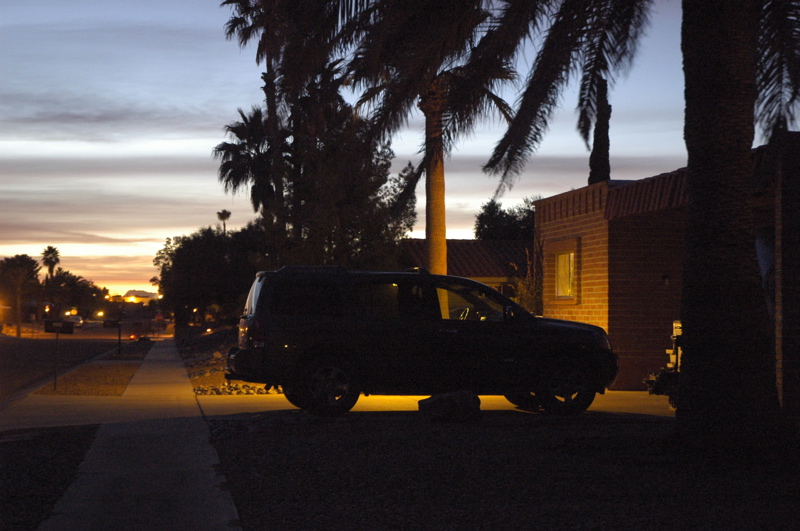On some evenings we have had the pleasure of the gentle hooting of an owl, just outside our house. We can hear him even when we are inside, so we know that he comes close. But we’ve never seen him, until tonight.
We were in the Airstream having dinner when we heard our neighbor Carol calling quietly, “Eleanor, are you there?” Carol is a birdwatcher. We piled out of the Airstream’s door and over to Carol’s back yard, where the silhouette of a large Great Horned Owl was clearly visible in a tree.
 He was communicating with another owl. The two were hooting back and forth to each other across the alley, and it wasn’t long before we spotted the second owl also perched high in a tree only about 300 feet away.
He was communicating with another owl. The two were hooting back and forth to each other across the alley, and it wasn’t long before we spotted the second owl also perched high in a tree only about 300 feet away.
I ran to the house to get my camera and tripod, but before I got back, the owl closest to us flew over to meet the second one. A few minutes later, perhaps after a little owl tryst, both disappeared.
This little episode reminds me that we don’t have to be out on the road for us to spot amazing little bits of nature. We’ve never seen a Great Horned Owl in the wild before. The one pictured above was a rescued bird in the West Yellowstone bear and wolf center. Having seen this magnificent owl puffing up his breast and hooting at us in a classroom made it all the more exciting to finally spot one in our back yard, even if all we could see was his silhouette and characteristic ear tufts.
Having failed to capture our owl visitor with my camera, I set up outside the house for some night photo practice. The tough thing about getting good night shots is knowing what’s in your frame. It’s hard to compose a shot in the dark, so often I’ll have to take several test shots just to get a sense of composition and set up the proper exposure.
 But night photography can be very rewarding, too. The drama of an ordinary suburban street can be magnified at dusk, and with a little tweaking of your camera’s exposure you can make dusk come earlier or later as you wish. I like doing it.
But night photography can be very rewarding, too. The drama of an ordinary suburban street can be magnified at dusk, and with a little tweaking of your camera’s exposure you can make dusk come earlier or later as you wish. I like doing it.
The photo at left was shot with a 1.6 second exposure at ISO 1600. Although you can’t see it in this reduced version, the full image is a bit grainy in the blacks, which is the price of using such a high ISO. It wouldn’t stand up to being even a half-page in the magazine, but for just playing around it’s fine.
I often get asked by people which camera they should buy. It’s not the camera so much as the photographer. If you want to buy something new, consider getting a tripod to start. Also make sure you know how to override the auto flash on your camera. Read the manual! You’ll be amazed at how much you can do even with an entry-level point-and-shoot digital camera these days. Take lots of pictures — they’re free (and don’t hesitate to delete the bad ones). And then, when you’ve got a good Airstream-related photo, put it up on our new Media Community so we can all see it!
As I write this, I can hear the hooting of the owl again. He’s back near the house. I’m going to leave my camera on the tripod for the next few days, and try to capture him at dusk. I don’t expect an amazing photo at the distance I’ll be shooting, but it will be interesting to see what I can get.


January 26th, 2008 at 11:24 am
looking forward to any night shots…owls would be great….